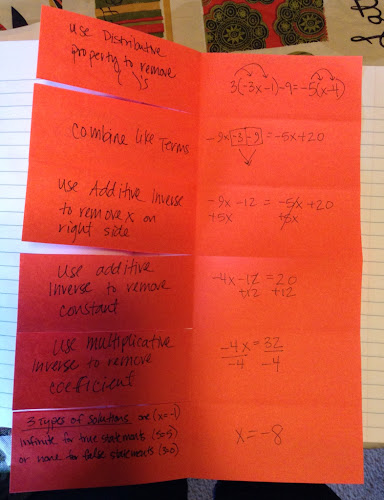In this entry, some time has passed in my algebra class. we've studied linear functions through various activities and have worked through various forms of solving equations. The lesson this was for was the multiple representations for functions. We needed to show a concrete model, the algebraic model, a graph, table and then the solution check. Instead of creating something, we cut out an example from our worksheet and glued it in. Well, they glued it, I just threw something in there to hold its place (again with the "not doing what they're doing" problem!) What you will see in the picture is my attempt to show the page we pasted in but as I looked closer, turns out I had the wrong worksheet. Since we've addressed my failings in previous posts, lets move on to picture.

As I reminisce about my journal, I shake my head. I know I can do better. The thought "what is the purpose of this?" has crossed my mind a lot lately. When I started my journal, I had some purpose but lost it along the way or that purpose became less meaningful (when the journal became a review at the end of the unit instead of it being a useful tool through the unit). That's not to say that I lost total purpose in algebra, I just didn't have follow through in journaling. That brings me to looking at my choices. If I continue to journal, I now know I need to stick to it and make sure the journal has purpose. If I don't journal, it's not the end of the world. There are many great teachers out there that don't journal and their students are successful as well. The main thing I need to remember is making sure my kids leave with a better understanding of algebra so that they are ready to take on the world, and hopefully have a better attitude towards math in general.
Back to multiple representations, I should have just used the four corner foldable. In one corner I could do the concrete model (algebra tiles), in another corner, algebra method with solution check, another corner has the table and the last have a graph. It could have been that simple. This year I will try the four corner since the kids will be used to it anyway.
As you go through my blog, keep in mind, I'm not an expert teacher. I chronicle my failures because I hope you see that not everyone is a great journaler but, that with some thought and a willingness to try again, you can be successful at what you chose to do.






















